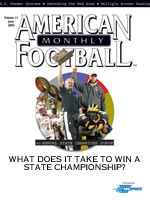AMERICAN FOOTBALL MONTHLY THE #1 RESOURCE FOR FOOTBALL COACHES
Article CategoriesAFM Magazine
|
The Multiple Screen Passing GameIt is my belief that no matter what offense you run, screen passes can be sucdessfully incorporated.Head Football Coach Iona College - New Rochelle, NY © More from this issue Various screen passes have been an important part of our multiple offensive attack at Iona College and all the other schools I have coached at (St. Joseph’s College, Morehead State University, Lehigh University and Fordham University) throughout my career. We have always emphasized the use of multiple formations, multiple personnel groupings, and a multi-dimensional offense that attacks the whole field and attempts to keep the defense off balance. It is also our intention to try and create preparation problems for the defense as they prepare for us during the week. With this in mind, we feel our screen game has fit in well with this philosophy and has been a very successful part of our offense. It is my bel....The full article can only be seen by subscribers. Subscribe today!
|
|
|||||||
| HOME |
MAGAZINE |
SUBSCRIBE | ONLINE COLUMNISTS | COACHING VIDEOS |
Copyright 2025, AmericanFootballMonthly.com
All Rights Reserved





